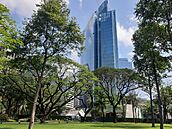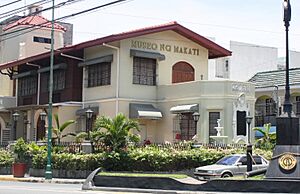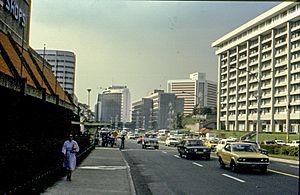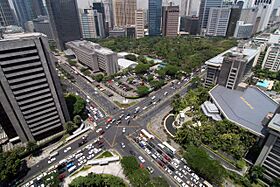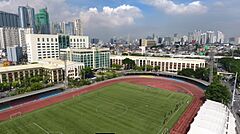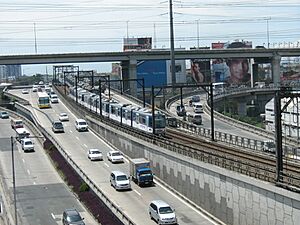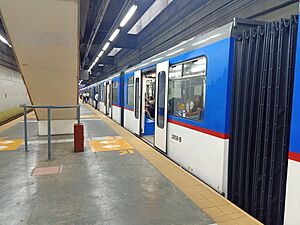Makati facts for kids
Quick facts for kids
Makati
|
|||||
|---|---|---|---|---|---|
|
Highly urbanized city
|
|||||
|
Makati Central Business District skyline
Paseo de Roxas
Ayala Triangle Gardens
Poblacion
Rockwell Center
Globe Circuit Events Ground
Philippine Stock Exchange Plaza
Makati City Hall
Nuestra Señora de Gracia Church
|
|||||
|
|||||
| Etymology: San Pedro [de] Macati | |||||
| Nickname(s):
Financial Capital of the Philippines
|
|||||
| Motto(s):
Makati, Mahalin Natin, Atin Ito.
("Makati, let us love it, it is ours.") |
|||||
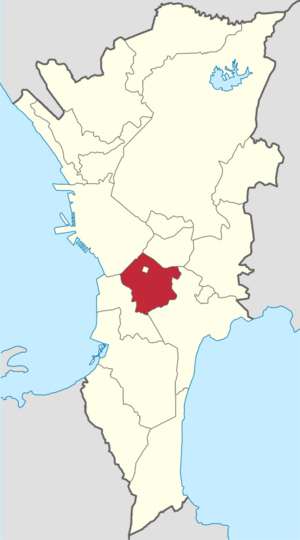
|
|||||
|
OpenStreetMap
|
|||||
| Country | Philippines | ||||
| Region | National Capital Region | ||||
| Province | none | ||||
| District | [[{{#property:P7938}} | — Lua error in Module:Wd at line 1804: attempt to index field 'wikibase' (a nil value).]] | ||||
| Founded | June 1, 1670 | ||||
| Renamed | February 28, 1914 (as Makati) | ||||
| Cityhood | February 4, 1995 | ||||
| Recent territorial change | November 9, 2023 | ||||
| Barangays | 23 (since 2023) | ||||
| Government | |||||
| • Type | Sangguniang Panlungsod | ||||
| Area | |||||
| • Total | 18.17 km2 (7.02 sq mi) | ||||
| Elevation | 32 m (105 ft) | ||||
| Highest elevation | 465 m (1,526 ft) | ||||
| Lowest elevation | 0 m (0 ft) | ||||
| Population
(2020 census)
|
|||||
| • Total | 292,743 | ||||
| • Density | 16,111/km2 (41,730/sq mi) | ||||
| • Households | 89,638 | ||||
| Demonym(s) | Makiteño; Makatizen | ||||
| Economy | |||||
| • Income class | 1st city income class | ||||
| • Poverty incidence |
|
||||
| • HDI | |||||
| • Revenue | ₱22,387,841,645.00 (2020) | ||||
| • Assets | ₱ 236,729 million (2020) | ||||
| • Expenditure | ₱ 19,273 million (2020) | ||||
| • Liabilities | ₱ 16,415 million (2020) | ||||
| Service provider | |||||
| • Electricity | Manila Electric Company (Meralco) | ||||
| Time zone | UTC+8 (PST) | ||||
| ZIP code |
1200–1213, 1219–1235
|
||||
| PSGC |
[https://psa.gov.ph/classification/psgc/?q=psgc/barangays/{{#pro000®code={{&provcode=
|
||||
| IDD : area code | +63 (0)02 | ||||
| Native languages | Tagalog | ||||
| Major religions | Roman Catholic Church | ||||
| Feast date | December 12 | ||||
| Catholic diocese | Roman Catholic Archdiocese of Manila | ||||
| Patron saint | St. Peter and St. Paul, Virgen de la Rosa | ||||
| Website | www |
||||
Makati (![]() i/məˈkɑːti/ mə-KAH-tee; Tagalog pronunciation: [mɐˈkaː.t̪ɪ]), officially the City of Makati (Filipino: Lungsod ng Makati), is a highly urbanized city in the National Capital Region of the Philippines, known for being one of the leading financial centers in the country. As of 2013, the city has the highest concentration of multinational and local corporations in the Philippines. Major banks, corporations, department stores as well as foreign embassies are based in Makati. Makati is also known for being a major cultural and entertainment hub in Metro Manila. According to the 2020 census, it had a population of 629,616 people, making it as the 47th most populous city in the country and ranked as the 43rd most densely populated city in the world with 19,336 inhabitants per square kilometer or 50,080 inhabitants per square mile.
i/məˈkɑːti/ mə-KAH-tee; Tagalog pronunciation: [mɐˈkaː.t̪ɪ]), officially the City of Makati (Filipino: Lungsod ng Makati), is a highly urbanized city in the National Capital Region of the Philippines, known for being one of the leading financial centers in the country. As of 2013, the city has the highest concentration of multinational and local corporations in the Philippines. Major banks, corporations, department stores as well as foreign embassies are based in Makati. Makati is also known for being a major cultural and entertainment hub in Metro Manila. According to the 2020 census, it had a population of 629,616 people, making it as the 47th most populous city in the country and ranked as the 43rd most densely populated city in the world with 19,336 inhabitants per square kilometer or 50,080 inhabitants per square mile.
In 2023, the ten Embo barangays were removed from Makati's jurisdiction as a result of the Makati–Taguig boundary dispute ruling, resulting in a reduction of the city's population to about 292,743. The daytime population of the city is estimated to be more than three million during a typical working day because of the large number of people who go to the city to work, shop, and do business.
Contents
Etymology
The name of Makati originates from the Tagalog word kati, meaning "[of the] low tide" or "[of the] ebb tide", attributing to the tidal movements of the adjacent Pasig River. Alternatively, the word may also mean "itchy", attributed to the lipang kalabaw plant (Dendrocnide meyeniana) that once grew in the area.
Previously, it was named San Pedro [de] Macati, a name stylized in Spanish. The first part of the name is derived from Spanish for Saint Peter, the then-town's patron saint.
History

Spanish colonial era
Parts of the city were once subject to the pre-Hispanic Kingdom of Namayan, whose capital is now in the Santa Ana district of Manila. While under the jurisdiction of the Franciscan friars during the 17th century, it was established as a town on June 1, 1670 under the name San Pedro Macati out of the then-town of Santa Ana de Sapa. The nearby Nuestra Señora de Gracia Church, changed into the "Our Lady of Guadalupe" church, welcomed an image of the Virgin Mary and devotees from Mexico, and one person from a family in Makati, the Montes De Oca family, which produced Isidoro Montes de Oca, who became pivotal in the Mexican war of Independence against Spain. This parish had a large spiritual jurisdiction in the province of Tondo (later known as Manila), extending up to the present-day Muntinlupa.
In 1851, Don José Bonifacio Roxas (an ancestor of the Zóbel de Ayala family) purchased the Jesuit estate of "Hacienda San Pedro de Macati" for 52,800 pesos. Since then, the development of Makati has remained linked with the Zóbel de Ayala family and their company, Ayala Corporation. In 1890, San Pedro de Macati was proclaimed as a public town of Manila province.
American occupation
In 1901, San Pedro Macati was incorporated into the newly established province of Rizal. On February 28, 1914, the name of the town was shortened to its present name of Makati, under Philippine Legislature Act No. 2390.
As of 1934, Makati had 14 barrios according to the Rizal provincial directory, namely: Poblacion, Comandante Carmona, Culiculi (present-day Pio del Pilar), Guadalupe, Fort McKinley, Malapadnabato (present-day West Rembo), Masilang (present-day South Cembo), Kasilawan, Olimpia (Olympia), Palanan, Pinagkaisajan (Pinagkaisahan), Rural, Sampalukan, and Tejeros. Fort McKinley, Malapadnabato, and Masilang were previously parts of Pateros.
Japanese occupation
On January 1, 1942, Makati was one of the municipalities of Rizal merged alongside Manila and Quezon City to form the City of Greater Manila as an emergency measure by President Manuel L. Quezon. It regained its pre-war status as a municipality of Rizal when the City of Greater Manila was dissolved by President Sergio Osmeña effective August 1, 1945.
Post-war Era
After the destruction that the Second World War brought upon Manila, and the subsequent closure of Nielson Field, the town grew rapidly, and real estate values boomed. The first of the planned communities (in what are now the barangays Forbes Park, Urdaneta, San Lorenzo, and Bel-Air established during those times) were established in the 1950s with the efforts of its landowner, Ayala y Compañía. At the same time, Fort McKinley, then renamed Fort Bonifacio, and the then Philippine Army headquarters, became the starting point for the building up of seven more communities by military families who worked in the base area. New office buildings were built on what is now the Makati Central Business District (CBD). Since the late 1960s, Makati has transformed into the financial and commercial capital of the country. In December 1972, two barangays of Makati were established at the Inner Fort Bonifacio area: Post Proper Northside and Post Proper Southside.
On November 7, 1975, Makati was separated from Rizal province to become part of the National Capital Region as a component municipality.
Martial Law and Corazon Aquino eras
The beginning months of the 1970s marked a period of turmoil and change in the Philippines, particularly for the areas near the capital. A sudden glut of debt driven public works projects in the late 1960s led the Philippine economy to a sudden downward turn known as the 1969 Philippine balance of payments crisis, which in turn led to a period of economic difficulty and social unrest. With only a year left in his last constitutionally allowed term as president Ferdinand Marcos placed the Philippines under Martial Law in September 1972 and thus retained the position for fourteen more years. This period in Philippine history is remembered for the Marcos administration's record of human rights abuses, particularly targeting political opponents, student activists, journalists, religious workers, farmers, and others who fought against the Marcos dictatorship.
Following the assassination of opposition senator Benigno Aquino Jr. on August 21, 1983, Makati became a nexus for protests against the dictatorship of President Ferdinand Marcos. Known as the Confetti Revolution, the demonstrations held in the central business district were led partly by employees of major corporations based in the area, culminating in the 1986 People Power Revolution that toppled Marcos' 20-year authoritarian regime. His political rival and successor, Corazon Aquino–the wife of the deceased senator Aquino–became the eleventh and first female president of the Philippines.
In January 1986, by virtue of Presidential Proclamation No. 2475, s. 1986, Fort Bonifacio and the Embo barangays of Cembo, South Cembo, West Rembo, East Rembo, Comembo, Pembo and Pitogo were transferred to the control of Makati. The proclamation was contested by Taguig because it altered the municipality's boundaries unconstitutionally, which resulted in a three-decade long territorial dispute.
After Mayor Nemesio Yabut succumbed to an illness on February 25, 1986, coinciding with the last day of the People Power Revolution, Aquino appointed Jejomar Binay as acting mayor of Makati two days later; he was subsequently elected as mayor in 1988.
During the 1989 Philippine coup attempt, the Makati central business district was occupied by Reform the Armed Forces Movement forces seeking to overthrow President Corazon Aquino. The resulting standoff lasted from December 2 to 9 and contributed to massive financial losses incurred due to the paralysis in the economic hub.
Cityhood
On January 2, 1995, President Fidel V. Ramos signed Republic Act No. 7854, making Makati the seventh city in Metro Manila. The law was approved by a plebiscite one month later, on February 2, 1995, by majority of voters.
Contemporary
On May 17, 2000, at 5:02 p.m. PHT, the Glorietta mall located inside the Ayala Center was bombed, injuring 13 persons. According to local authorities, the homemade bomb originated from the restroom of a restaurant and affected an adjacent video arcade. The bombing was said to be the precursor of the May 21, 2000 SM Megamall bombing and the Rizal Day bombings.
On October 19, 2007, an explosion in Glorietta 2 left eleven people dead and injured more than a hundred. Initially, authorities said that it was caused by a liquefied petroleum gas explosion at a restaurant, but later began investigating the possibility that the explosion may have been a C-4 bomb.
In April 2022, Makati lost in the decades long the territorial dispute with Taguig, which was ruled with finality a year later in April 2023. The city ceded its territorial and political jurisdiction of the ten Embo barangays to Taguig, thus losing an estimated 300,000 people from its population. However, disputes regarding public facilities like schools and health centers, persists.
Because of Taguig's territorial takeover, Makati's 2nd district, which has three barangays remaining in this city, is put into limbo as it does not meet the constitutional requirement of 250,000 people and may be reduced back to a single congressional district. But pending legislation, the status quo of its existence is expected to prevail.
Geography
Makati is located within the circle of 14′40″ °N and 121′3″ °E right at the center of Metro Manila. The city is bounded on the north by the Pasig River, facing Mandaluyong, on the east by Taguig, on the southwest by Pasay, and on the northwest by the city of Manila. Makati has a total land area of 21.57 square kilometers (8.33 sq mi). Its territory also surrounds the Manila South Cemetery, an exclave of San Andres district of Manila.
Barangays
Since November 2023, Makati is divided into 23 barangays (the smallest local government units) which handle governance in a much smaller area. These barangays are grouped into two congressional districts where each district is represented by a congressman in the country's House of Representatives. The 1st Congressional District is composed of the barangays straddling EDSA, the barangays to the north and west of them, while excluding Guadalupe Viejo, while the 2nd Congressional District is to the south and east of the 1st District, including the aforementioned barangay. The districts elect the sixteen members of the city council, eight from each of the two councilor districts that are coextensive with the congressional districts.
Cembo, South Cembo, West Rembo, East Rembo, Comembo, Pembo, Pitogo, Post Proper Northside, Post Proper Southside, and Rizal, collectively known as the Embo barangays, were officially part of Makati from 1986 to 2023, when these were transferred to Taguig by virtue of the Supreme Court's ruling that year to finally side with Taguig regarding the cities' territorial dispute.
| Barangay | Area (km2) | Population (2010) | Population (2015) | Population (2020) |
|---|---|---|---|---|
| Bangkal | 0.74 | 23,378 | 21,650 | 17,576 |
| Bel-Air | 1.71 | 18,280 | 23,685 | 36,007 |
| Carmona | 0.34 | 3,096 | 3,109 | 2,745 |
| Dasmariñas | 1.90 | 5,654 | 5,589 | 4,160 |
| Forbes Park | 2.53 | 2,533 | 2,335 | 3,715 |
| Guadalupe Nuevo | 0.57 | 18,271 | 18,341 | 20,533 |
| Guadalupe Viejo | 0.62 | 16,411 | 13,415 | 12,900 |
| Kasilawan | 0.09 | 5,291 | 5,881 | 4,827 |
| La Paz | 0.32 | 7,931 | 7,356 | 6,346 |
| Magallanes | 1.20 | 5,576 | 5,672 | 5,267 |
| Olympia | 1.20 | 21,270 | 20,251 | 18,654 |
| Palanan | 0.65 | 17,283 | 14,110 | 11,623 |
| Pinagkaisahan | 0.16 | 5,804 | 5,468 | 4,710 |
| Pio del Pilar | 1.20 | 27,035 | 30,732 | 50,722 |
| Poblacion | 0.46 | 17,120 | 25,393 | 16,706 |
| San Antonio | 0.89 | 11,443 | 16,840 | 17,494 |
| San Isidro | 0.50 | 7,589 | 8,045 | 6,098 |
| San Lorenzo | 2.09 | 10,006 | 12,995 | 14,054 |
| Singkamas | 0.13 | 7,426 | 7,370 | 7,218 |
| Sta. Cruz | 0.47 | 7,440 | 7,207 | 6,333 |
| Tejeros | 0.29 | 13,868 | 13,696 | 15,122 |
| Urdaneta | 0.74 | 3,717 | 4,429 | 4,563 |
| Valenzuela | 0.24 | 7,261 | 6,310 | 5,370 |
Climate
Under the Köppen climate classification system, the city features a tropical monsoon climate. Together with the rest of the Philippines, Makati lies entirely within the tropics. Its proximity to the equator means that the temperature range is very small, rarely going lower than 20 °C (68 °F) or going higher than 38 °C (100 °F). However, humidity levels are usually very high which makes it feel much warmer. It has a distinct, albeit relatively short dry season from January through May, and a relatively lengthy wet season from June through December.
| Climate data for Makati | |||||||||||||
|---|---|---|---|---|---|---|---|---|---|---|---|---|---|
| Month | Jan | Feb | Mar | Apr | May | Jun | Jul | Aug | Sep | Oct | Nov | Dec | Year |
| Mean daily maximum °C (°F) | 30 (86) |
30 (86) |
31 (88) |
33 (91) |
34 (93) |
34 (93) |
33 (91) |
31 (88) |
31 (88) |
31 (88) |
31 (88) |
31 (88) |
31.7 (89.1) |
| Mean daily minimum °C (°F) | 21 (70) |
21 (70) |
21 (70) |
22 (72) |
23 (73) |
24 (75) |
24 (75) |
24 (75) |
24 (75) |
24 (75) |
23 (73) |
22 (72) |
22.75 (72.95) |
| Average precipitation mm (inches) | 25.4 (1.00) |
25.4 (1.00) |
38.1 (1.50) |
25.4 (1.00) |
38.1 (1.50) |
127 (5.0) |
254 (10.0) |
431.8 (17.00) |
406.4 (16.00) |
355.6 (14.00) |
203.2 (8.00) |
152.4 (6.00) |
2,082.8 (82.00) |
| Source: makaticity.com | |||||||||||||
Climate change
The Global Climate Risk Index 2021 lists the Philippines as one of countries most affected by catastrophes due to extreme weather events. Makati is a low-lying, coastal city vulnerable to natural calamities intensified by climate change, such as typhoons, floods, and landslides. The city's disaster risk reduction and management office noted a rise in rainfall experienced by the city over the years, particularly during the rainy season.
In August 2022, the city government declared a climate emergency, amid rising sea levels and global temperature changes.
Makati undertakes climate adaptation programs to address vulnerabilities to climate change, which include health services to residents, emergency response, and environmental management and protection. It intends to increase projects to address climate change, including a planned purchase of more electric vehicles, installation of solar panels in public schools and government offices, and improvement of public transport to lessen greenhouse gas emissions.
Cityscape
Demographics
As of the 2020 census, Makati had a population of 629,616. The count was later reduced to 292,743 in 2023 based on the same census when the Embo barangays were transferred to Taguig as a result of the cities' territorial dispute ruling. Makati currently ranks 14th in population size within Metro Manila. A majority of Makati residents identified their religious affiliation as Roman Catholic. Other groups having large number of members in the city are the Church of Jesus Christ of Latter-day Saints, Members Church of God International, Evangelical Christians, Iglesia ni Cristo, Protestantism, Islam, Hinduism, Buddhism and Judaism.
Based on the city's Transport and Traffic Improvement Plan 2004–2014, the city's daytime population is estimated to be 3.7 million during weekdays, owing to the large number of people who come to work, do business, or shop.
The daily influx of people into the city provides the skilled labor force that allows Makati to handle the service requirements of domestic as well as international transactions; it also serves as the base of a large consumer market that fuels the retail and service trade in the city. At the same time, however, the large tidal population flows exert pressure on Makati's environment, services, and utilities, most noticeably causing large traffic volumes along the major road corridors leading to the city as well as within and at the periphery of the central business district.
Economy and infrastructure
| Source: Philippine Statistics Authority |
|
The economy of Makati is diverse and multifaceted. Makati is the home to the Ayala Triangle in the Makati Central Business District, which is home to many multinational companies, banks, and other major businesses. A few upscale boutiques, restaurants, and a park called Ayala Triangle Gardens are also located in the area. The Makati Business Club has over 800 chief executive officers and senior executives, which represents 450 of the country's biggest corporations. The biggest trading floor of the Philippine Stock Exchange used to be situated along the city's Ayala Avenue, before the stock exchange moved their headquarters to the Bonifacio Global City in Taguig. The city has an office space supply of 2.8 million square meters (30 million square feet) as of end-2021, making it a dominant office market in Metro Manila alongside Taguig and Pasig. As of 2023, Taguig had the highest share of existing office supply in Metro Manila at 26 percent, followed by Makati at 20 percent.
Makati is the second top revenue earner in the National Capital Region, following Quezon City at first place. The city has not increased its tax rates since its new Revenue Code took effect in 2006, and has been free of deficit for about three decades.
Most of the tallest skyscrapers in Metro Manila and the Philippines are located in Makati. Among them are the PBCom Tower, Trump Tower Manila and Gramercy Residences in Century City, Discovery Primea, Shang Salcedo Place, and G.T. International Tower. PBCom Tower along Ayala Avenue was the country's tallest office building from 2001 to 2017, with a total ground-to-architectural-top height of 259 meters (850 ft). It was surpassed in 2017 by the Metrobank Center in Taguig with a total architectural height of 318 m (1,043.3 ft).
In addition, Evangelista Street in Barangay Bangkal is known for being the site of automobile repair shops, replacement automobile parts stores, tire and wheel stores, car air-conditioning unit repair shops, and car tint stores, almost similar to Banawe Street in Quezon City.
Shopping centers
Makati is one of the most well-known shopping hubs of Metro Manila. Various shopping centers, offering both international and local retail shops, high-end boutiques, dining outlets and entertainment facilities can be found around the city.
The Ayala Center is a major commercial development operated by Ayala Land located in the Makati CBD. The center is known for its wide array of shopping, entertainment, and cultural offerings, making it a premier shopping and cultural district in the metropolis. It is a vast walkable complex with high-end malls that houses cinemas, local and international shops, homegrown restaurants and international food chains. The shopping malls that are located at the Ayala Center include Greenbelt, Glorietta, Park Square, The Link, and Ayala Malls One Ayala. The Ayala Center is also home to three department stores, namely: SM Makati, Rustan's, and The Landmark.
Other shopping centers in Makati include Power Plant Mall at Rockwell Center, Century City Mall at Century City, Ayala Malls Circuit at Circuit Makati, Cash & Carry Mall, Walter Mart Makati, Makati Central Square (formerly Makati Cinema Square), Guadalupe Commercial Center, Paseo de Magallanes, and pocket malls at various high-rise residential condominiums or office buildings in the city.
Education
The University of Makati, a public, non-profit university, is the city's flagship university located in West Rembo, its former barangay that is now part of Taguig. Other institutions of higher education located in the city include the Asian Institute of Management (AIM), iAcademy, Asian Seminary of Christian Ministries (ASCM), Don Bosco Technical Institute of Makati, Assumption College San Lorenzo, Saint Paul College of Makati, Our Lady of Guadalupe Minor Seminary, and Asia Pacific College.
Several higher education institutions headquartered outside the city have established branch or satellite campuses in Makati. These include the Ateneo de Manila University (Ateneo Professional Schools), De La Salle University, Far Eastern University, Mapúa University, Lyceum of the Philippines University, Centro Escolar University, and AMA Computer College Colleges, among others.
Australian Catholic University, a foreign institution, maintains an extension program in Makati.
As of 2024, the Schools Division Office (SDO) of Makati City oversees 23 public schools: 16 elementary schools and 7 high schools. In 2023, as a result of the Makati–Taguig boundary dispute ruling, 14 public elementary and high schools, including the Makati Science High School, were transferred from the SDO of Makati City to the SDO of Taguig City and Pateros. Makati later appealed to the national Department of Education to retain the management of Makati Science High School, Fort Bonifacio Elementary School, and Fort Bonifacio High School, but the city's appeal was denied, leaving the city without a science high school.
Rafael Palma Elementary School, which is under the jurisdiction of the neighboring city of Manila's Schools Division Office, is located in Barangay La Paz, near the Makati–Manila boundary.
Culture and sports
Makati is home to a number of fine art museums, colonial-era churches and recreation areas. Along the south-eastern border of Makati beyond Forbes Park are the Manila Golf Club and the Manila Polo Club. The Manila Golf Club features an 18-hole golf course. The Manila Polo Club counts among its polo enthusiasts some of the country's wealthiest people. The Makati Sports Club in Salcedo Village is another popular place for sports. The Makati Coliseum is another famous sports landmark in the city, where some of the biggest sports gatherings are held.
The city's only professional sports team is the Makati OKBet Kings, which joined the Maharlika Pilipinas Basketball League in its second season.
In the northwest, the Blue Pitch at Circuit Makati is a multi-use stadium, used not just for football games but since 2017 serves as the primary hub of the Philippine-American Football League. The site of Circuit Makati was also previously occupied by the Santa Ana Park, a racetrack whose operations were transferred to Naic, Cavite in 2009. The University of Makati Stadium, now part of Taguig, was the home venue of Philippines Football League club Kaya F.C.–Makati until the team's move to Iloilo City.
The Ayala Museum is a private fine arts and history museum housing various exhibitions such as the "Gold of Ancestors," an exhibition of more than one thousand golden pre-Hispanic artifacts. Other popular museums also in Makati also include the Yuchengco Museum and the Museo ng Makati.
Makati has several Spanish-era churches, such as the Saints Peter and Paul Parish, Our Lady of Guadalupe Parish and the Nuestra Señora de Gracia Church (Our Lady of Grace) in the old town. At the Greenbelt Park stands the modern domed Sto. Niño de Paz Greenbelt Chapel. Located in Forbes Park is the Santuario de San Antonio, a popular church for weddings in the Makati area. The National Shrine of the Sacred Heart is located in San Antonio Village. Makati also houses the country's only Jewish synagogue, Beth Yaacov.
Future development
Ayala Land and the Makati Tourism Foundation launched a year-long campaign titled "Make It Happen, Make it Makati" to increase Makati's visibility as an arts and culture destination. The campaign is part of Ayala's ongoing US$1.5 billion redevelopment masterplan for Makati, which began in 2011 and divides the city into six distinct hubs for business, lifestyle, entertainment and transport.
Transportation
Major roads in Metro Manila surround Makati, such as Epifanio de los Santos Avenue (EDSA), located in the southwestern part of the city, the Osmeña Highway and South Luzon Expressway (SLEX), collectively known as South Superhighway (SSH), and the Skyway, which is built on top of both roads.
Land
Two of Metro Manila's main arteries pass through Makati. The Epifanio de los Santos Avenue (EDSA) pass along the city's southeast part and connects it with the cities of Mandaluyong and Pasay. The South Luzon Expressway (SLEX) starts in southwestern Makati and connects it with southern Metro Manila and Southern Luzon. The Skyway is an elevated expressway that connects with NLEX and SLEX, providing residents coming from Northern Luzon, Northern Metro Manila, Southern Luzon and other cities of Southern Metro Manila a fast way to reach Makati. SLEX and EDSA intersect at the Magallanes Interchange, which is the most complex system of elevated roadways in Metro Manila.
The areas of Guadalupe and of Ayala Center are considered as major transport hubs. Ayala Center hosts One Ayala, a complex with an intermodal transport hub, and various public transportation stops. The BGC Bus also connects the city to Bonifacio Global City, with a terminal at the McKinley Exchange Corporate Center near Ayala Center. Provincial and city buses, including Premium Point-to-Point Bus Service, ply the city through EDSA, Osmeña Highway, Kalayaan Avenue, or the central business/financial district towards other parts of Metro Manila and Southern Luzon. Jeepneys ply Makati's inner roads and connect the city to its surrounding towns and cities. Tricycles are also used for shorter distances except at most of the Central Business District, exclusive villages, and some major roads.
The country's first-ever e-jeepney and hybrid bus services were piloted in Makati. The buses are parallel electric hybrids, powered by an electric motor and a Euro 3 diesel motor. The hybrid buses ply the route from Gil Puyat Avenue (Tramo area) to Kalayaan Avenue (near C-5), which are considered among the busiest in the city's central business district, cutting through other major roads like Osmeña Highway; Chino Roces, Ayala and Makati Avenues; Paseo de Roxas and EDSA.
Other major roads in the city include Gil Puyat Avenue, which connects EDSA and SLEX in the north; Ayala Avenue, an important street that runs through the Makati CBD; McKinley Road, which connects the city to Bonifacio Global City; Arnaiz Avenue, which connects the city to Pasay; Osmeña Highway, which connects SLEX to the city of Manila; Makati Avenue, which connects the Makati CBD to Poblacion, also extending north to the Makati–Mandaluyong Bridge; and J. P. Rizal Avenue, the oldest main thoroughfare of Makati which connects it to the cities of Manila and Taguig. At the center of Makati is the Ayala Triangle, a park built on the former Nielson Air Base. According to the city's Department of Engineering and Public Works, the city had 261.573 kilometers (162.534 mi) of concrete roads and 74.068 kilometers (46.024 mi) of asphalt roads prior to the transfer of Embo barangays to Taguig.
Railways
Manila Metro Rail Transit System Line 3 (MRT Line 3) on EDSA has four stations located in Makati: Guadalupe, Buendia, Ayala and Magallanes.
The Philippine National Railways has three stations in the city: Dela Rosa, Pasay Road and EDSA. Pasay Road, formerly known as Culi-culi and Pio del Pilar, is the first railway station in Makati, having been initially opened in 1908. Dela Rosa replaced the old Buendia station in 2017. All aforementioned stations are part of the PNR South Main Line. The operations of PNR Metro Commuter Line, which serves the South Main Line, is currently suspended due to the construction of North–South Commuter Railway, which will have stations at Buendia and EDSA.
In 2013, the National Economic and Development Authority (NEDA) worked on a feasibility study for a $1.75 billion monorail project. The proposed 12.56-kilometer (7.80 mi) elevated monorail is envisioned to connect Makati, Bonifacio Global City and Pasay through MRT Line 3, as well as Ninoy Aquino International Airport. The present alignment being considered starts from the Guadalupe MRT station, enters Bonifacio Global City through the north gate and ends at Ninoy Aquino International Airport Terminal 3.
In 2015, NEDA approved the Public-Private Partnership project for the Makati-Pasay-Taguig Mass Transit System Loop which will have stations at key points in Makati, namely: Buendia MRT station, Ayala-EDSA, Ayala Triangle, Makati Post Office and PNR-Buendia. The project was later shelved and partially revived in 2018 as the Makati Intra-City Subway which inherits most of the stations in Makati. The Intra-City Subway project was later stalled in 2023 due to the transfer of the Embo barangays to Taguig, which won the territorial dispute with Makati.
Water
The Pasig River is located north of Makati. The Pasig River Ferry Service has one station in Makati located in Valenzuela.
International relations
Diplomatic missions
Most of the diplomatic missions to Manila by foreign countries in the Philippines have their chanceries located in Makati:
 Angola
Angola Argentina
Argentina Australia
Australia Austria
Austria Bangladesh
Bangladesh Belgium
Belgium Brazil
Brazil Brunei
Brunei Bulgaria (Consulate)
Bulgaria (Consulate) Cambodia
Cambodia Canada
Canada Chile
Chile China
China Czechia
Czechia Egypt
Egypt Finland
Finland France
France Germany
Germany Greece
Greece India
India Indonesia
Indonesia Iran
Iran Iraq
Iraq Ireland
Ireland Italy
Italy Libya
Libya Laos
Laos Malta
Malta Malaysia
Malaysia Mexico
Mexico Morocco
Morocco Myanmar
Myanmar Netherlands
Netherlands New Zealand
New Zealand Nigeria
Nigeria Pakistan
Pakistan Peru
Peru Panama
Panama Papua New Guinea
Papua New Guinea Portugal
Portugal Qatar
Qatar Romania
Romania Russia
Russia Saudi Arabia
Saudi Arabia South Africa
South Africa Spain
Spain Sri Lanka
Sri Lanka Switzerland
Switzerland Taiwan (Taipei Economic and Cultural Office)
Taiwan (Taipei Economic and Cultural Office) Ukraine (Consulate)
Ukraine (Consulate) Thailand
Thailand Turkey
Turkey Venezuela
Venezuela
Sister cities
Makati's sister city is Los Angeles, California. Makati is also twinned with Ramapo, New York and Vladivostok, Russia.
| International |
|---|
|
| Domestic |
|---|
|
Notable persons
- Pío del Pilar, Filipino revolutionary general
- Jejomar Binay, former Vice President of the Philippines
- Nancy Binay, incumbent senator
- Abigail Binay, lawyer and incumbent city mayor
- Michelle Dee, actress
- Vhong Navarro, TV host, actor and dancer
- Ciara Sotto, actress
- Julia Clarete, actress
- China Roces, actress
- Jhong Hilario, actor, dancer, TV host and incumbent 1st district councilor
- Teodoro Locsin Jr., journalist, lawyer, diplomat and former 1st district representative
- Monsour del Rosario, actor, athlete and former 1st district representative
- Joker Arroyo, lawyer, former 1st district representative and former Senator
- Agapito Aquino, former senator and former 2nd district representative
- Rico J. Puno, singer and former 1st district councilor
- Kid Peña, incumbent 1st district representative
- Chiquito, actor and former vice mayor
- Sandro Reyes, football player
- Rhian Ramos, actress
- Mike Arroyo, former First Gentleman
- Bela Padilla, actress
- Heaven Peralejo, actress
- Albie Casiño, actor
- CJ Tañedo, painter
See also
 In Spanish: Macati para niños
In Spanish: Macati para niños




